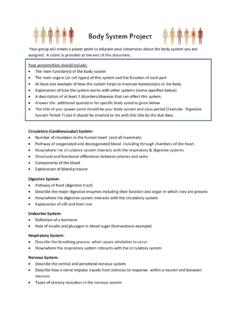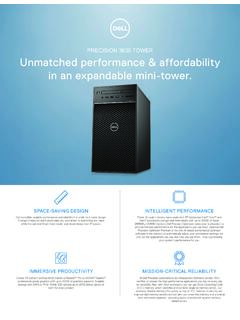Transcription of Force, Mass, and Acceleration Practice Problems
1 Name_____Per. _____ Force, Mass, and Acceleration Practice Problems Formulas: Fnet = ma (net Force = mass times Acceleration ) a = v ( Acceleration = change in velocity divided by change in time) t F v Units: Force: Newtons (N) Acceleration : m/sec/sec or m/sec2 velocity: m/sec Conversions: 1 kg = 1000 g m a a t 1 kg weighs ~ 10 N on Earth 1 N = 1 kg-m/sec2 Problems : 1. Two cars accelerate at 2 m/sec2. Car A has a mass of 750 kg, while Car B has a mass of 1000 kg. What forces are required to accelerate each car? If you are concerned with the price of gas, which car would you rather drive and why?
2 2. A 500 kg rocket can accelerate from rest to a speed of 600 m/sec in 2 seconds. 2a. What is the Acceleration of the rocket? 2b. How much force is required to accelerate it? 2c. How much force would be required to accelerate the rocket if it s mass were twice as much (1000 kg)? Why is payload (the amount of material a rocket carries into space) of extreme importance to rocket scientists? 3. A 100 kg man takes a ride on an elevator. (A) At first it is at rest on the ground floor. (B) It accelerates upward uniformly at 2 m/sec2 for a few seconds, then (C) it continues to go up at a constant velocity of 5 m/sec. 3a. Draw and label the forces on the man in during parts A, B, and C of his trip: A.
3 Net Force = _____ B. Net Force = _____ C. Net Force = _____ If the man is standing on a scale (measuring weight in N) in the elevator, what will it read in Part A? _____ Part B? _____ Part C? _____ 3b. Now the man rides down in the elevator. (D) It accelerates downward uniformly at 2 m/sec2 for a few seconds, then (E) the elevator cable breaks and the man goes into freefall. Draw and label the forces on the man in during parts D and E of his trip: D. Net Force = _____ E. Net Force = _____ If the man is standing on a scale (measuring weight in N) in the elevator, what will it read in Part D? _____ Part E? _____ 4. A satellite in space fires its thrusters for 10 seconds to give itself an added velocity of 2 m/sec.
4 Its constant thrusting force is 800 N during this time. What is the mass of the satellite? (Hint: find the Acceleration of the satellite first) 5. A rocket in space has a mass of 5000 kg, and is propelled by a rocket motor with 900,000 N of thrust, which burns for 4 seconds. 5a. What is the rocket s Acceleration ? 5b. If the rocket starts at rest, how fast is the rocket going after the 4 second burn? 6. A 2 kg block is dragged across a table top at a constant velocity by means of a spring scale (force meter) attached horizontally to the block. The scale shows a reading of 4 N at any constant velocity. This means that the frictional force between the block and the table is 4 N, and is not dependent on speed.
5 Draw the forces on the block: Net force = _____ 6b. The block is now pulled with a constant force of 10 N, which accelerates the block across the table top. Draw the forces on the block: Net force = _____ 6c. What is the Acceleration of the block due to this net force? 7. A 75 kg man stands in an elevator. What force does the floor exert on him when the Force Diagrams for man: a.
6 Starts moving upward with an Acceleration of m/sec2? b. moves upward with a constant speed of m/sec? c. starts accelerating downward at m/sec2? 8. A boy drops a 5 kg ball off a bridge. Ignoring air resistance, answer the following questions. 8a. Draw a force diagram for the freely falling ball. 8b. What is the net force on the ball? 8c. What is the Acceleration of the ball? 8d. How fast is the ball moving after it has been falling for 2 seconds?









